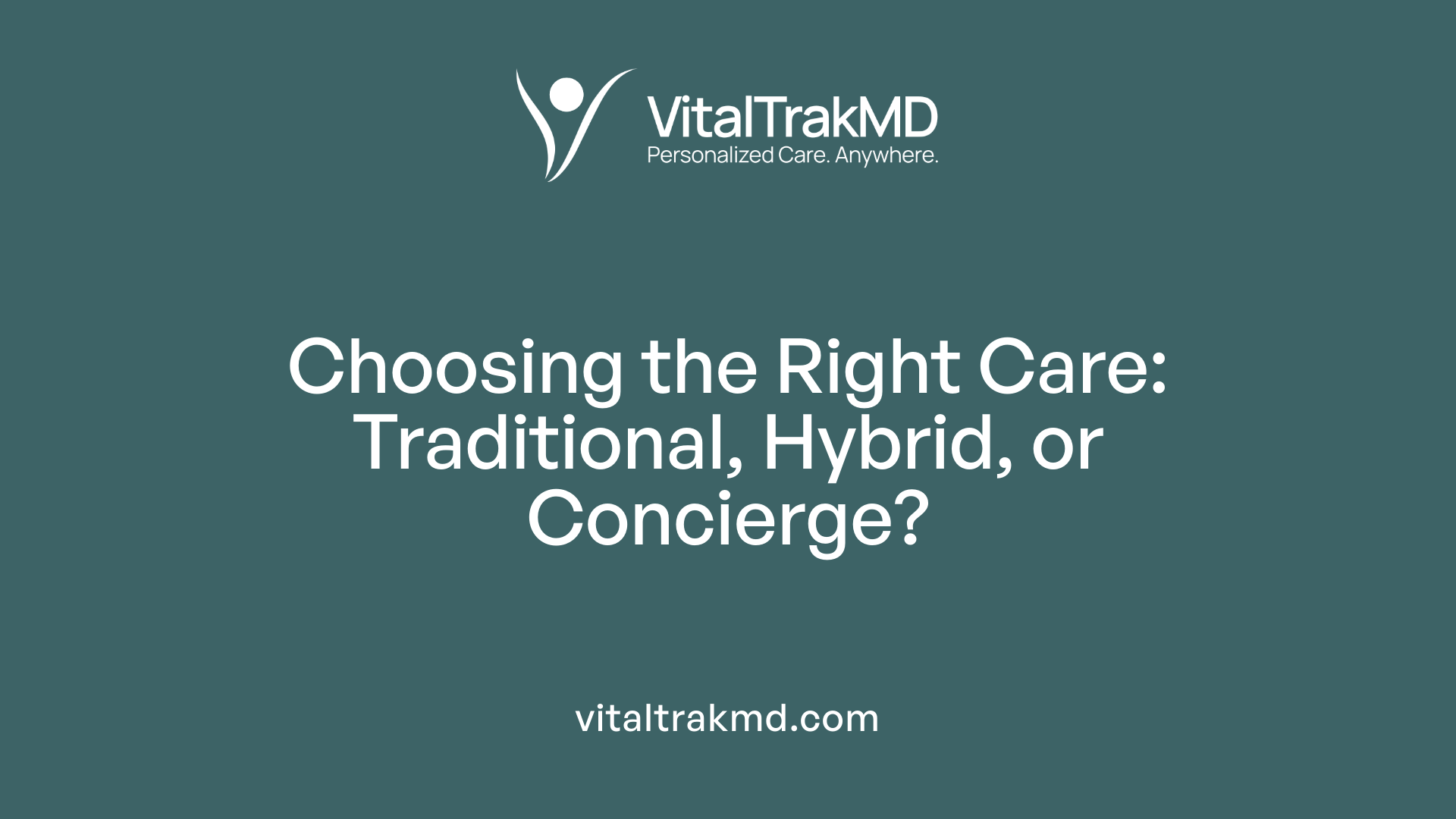Comparing Hybrid Care to Concierge Medicine Services

Understanding the Spectrum of Modern Primary Care
The landscape of primary healthcare has evolved significantly in recent years, driven by patient demand for personalized services, physician burnout concerns, and technological advances. Among the most prominent innovations are hybrid care models and concierge medicine services, each offering unique benefits, cost implications, and operational structures. This article explores these models in depth, comparing their features, advantages, and future prospects, to inform patients and providers navigating today's complex healthcare environment.
Defining Hybrid Care and Concierge Medicine

Overview of hybrid healthcare models
Hybrid healthcare practices combine elements of traditional primary care with concierge services, aiming to deliver personalized, accessible, and preventive care while maintaining the broad coverage of traditional models. These practices typically serve all patients under standard insurance reimbursement but offer a smaller subset of patients additional, enhanced services for a flat or retainer fee. Patients in hybrid models often enjoy benefits such as longer appointments, direct communication with their physicians, and wellness visits outside routine insurance coverage. This model provides flexibility for both physicians and patients, allowing a personalized approach within a sustainable practice structure.
Features of concierge medicine services
Concierge medicine, also known as retainer or boutique medicine, emphasizes an exclusive, high-touch healthcare experience. Patients pay an annual membership fee—usually ranging from $2,000 to over $10,000—granting them benefits like same-day or next-day appointments, 24/7 access via cell phone or email, and extensive wellness services. Concierge practices generally maintain small patient panels, often between 50 and 600 individuals, to ensure personalized care. Their services include longer consultation times (sometimes exceeding 60 minutes), comprehensive preventive care, and coordination of specialist or hospital services. Some practices also add luxurious elements like private accommodations and worldwide healthcare access.
Differences in care scope and structure
| Aspect | Hybrid Care | Concierge Medicine | Traditional Primary Care |
|---|---|---|---|
| Insurance Acceptance | Yes, often combined with concierge fees | Usually accepts insurance for covered services | Fully insurance-based |
| Patient Panel Size | Larger, potentially up to 150-300 patients | Small, typically 50-600 patients | Large, often 3,000-4,000 patients |
| Membership or Retainer Fee | Common, less than 10% of patients participate | Significant, often $2,000-$10,000+ annually | No fee for basic primary care |
| Access and Availability | Enhanced but not complete 24/7 access | 24/7 direct communication, same-day appointments | Standard hours, longer waits |
| Visit Duration | Longer than traditional but variable | Often exceeding 60 minutes | Usually 15 minutes or less |
| Service Focus | Preventive, wellness, personalized | Preventive, wellness, high-touch, luxury | Reactive, episodic, general health concerns |
| Cost | Under $2,000 annually, affordable for many | From $2,000 to over $10,000 annually | Covered mainly by insurance |
| Suitability | Stable patients, those seeking personalized care | Affluent, those valuing luxury, flexible access | General population, cost-sensitive |
| Examples in Practice | Dr. Gary Levinson manages 3,500-4,000 patients with small concierge panel | Exclusive clinics offering high-end amenities | Conventional clinics with broad patient base |
How hybrid care operates in practice
In hybrid practices, physicians often retain most of their traditional patient base while selectively offering enhanced services for an additional fee. Patients may receive benefits like additional time during visits, faster scheduling, and direct access via phone or email. Many physicians introduce these options gradually, often through informational letters or meetings, and may designate specific staff or time blocks for concierge patients. This arrangement aims to improve physician well-being, reduce burnout, and deliver higher-quality, personalized care without sacrificing the stability of insurance-based revenue.
Benefits and drawbacks
| Benefit | Hybrid Care | Concierge Medicine | Traditional Primary Care |
|---|---|---|---|
| Personalized Service | Yes, but within larger panels | Very high, exclusive, personalized | Basic, with less tailored attention |
| Access to Physicians | Improved, but not constant | 24/7, immediate, extensive access | Limited, scheduled appointments |
| Physician Satisfaction | Increased, reduced burnout | Very high, autonomy and control | Variable, often busy and strained |
| Cost | Generally affordable, under $2,000 | Higher, $2,000-$10,000+ annually | Covered by insurance, predictable costs |
| Accessibility | Enhanced but still insurance-based | Premium, luxury services | Standard, wait times and availability |
| Potential Disadvantages | Complexity, possible higher costs | Limited to wealthy, potential inequity | Less personalized, less accessible |
Future trends and implications
Looking ahead, hybrid and concierge care are poised to incorporate cutting-edge technology like telehealth, wearable devices, and data analytics to enhance personalized health management. These models are likely to expand in diverse settings, addressing the challenge of healthcare accessibility and equity. Increasing integration of digital tools can make these services more scalable, affordable, and proactive.
However, concerns about disparities remain, especially when high costs limit access. Innovations in flexible pricing, insurance partnerships, and policy support may help mitigate these issues. As physician workflows adapt, reducing burnout and improving patient outcomes through stronger relationships and preventive care will remain central to the evolution of these models.
Overall, the trajectory points toward a more personalized, efficient, and patient-centered healthcare environment, blending technology, innovation, and compassionate care.
Operational Structures and Revenue Models

How do hybrid practices maintain patient diversity and insurance revenue?
Hybrid practices skillfully balance traditional insurance-based care with concierge services, thereby maintaining a broad patient demographic. They accept insurance for services that are covered, ensuring access for a wide range of patients, while offering enhanced, fee-based services for those willing to pay extra. This dual approach allows physicians to sustain their revenue streams from insurance reimbursements—including routine visits, tests, and procedures—while generating additional income from premium services.
By doing so, hybrid practices avoid alienating lower-income or less affluent patients who rely on insurance coverage, while still attracting patients seeking personalized care. The flexibility in billing and service offerings helps practices diversify their patient panels, making them resilient against market fluctuations in insurance reimbursement rates.
What is the average cost of concierge medicine?
The average cost of concierge medicine generally ranges from about $2,000 to $5,000 per year, making it accessible to a broader population beyond luxury care. Some practices may charge higher fees, such as $10,000 or more annually, especially for comprehensive or premium services. Costs vary depending on factors like location, scope of services, and the level of personalized care provided by the physician.
Payment is typically out-of-pocket, though flexible spending accounts like HSAs or FSAs can sometimes be used. Overall, concierge medicine offers enhanced access, longer appointments, and preventive care, with costs reflecting these personalized and comprehensive healthcare benefits.
How do hybrid care models operate compared to concierge services?
Hybrid care models combine the traditional insurance-based healthcare approach with optional concierge services, providing a flexible system. Physicians in hybrid practices serve all their patients regardless of whether they pay extra fees, but they offer added benefits such as longer appointments, quicker access, and personalized wellness visits to a subset of patients who opt in.
Contrasting with pure concierge practices, which often serve fewer patients solely through membership fees, hybrid models retain larger patient panels while still providing exclusive services. Patients in hybrid practices typically pay a flat fee—often less than $150 per month—for extra services like direct communication or VIP scheduling, while their primary care remains covered by insurance.
This operational structure reduces physician stress and burnout, improves patient satisfaction, and keeps the practice financially viable without abandoning the traditional patient base.
What are the benefits and disadvantages of hybrid care versus concierge medicine?
Hybrid care offers a flexible and inclusive approach, accommodating a diverse patient population while providing enhanced physician-patient interactions. It helps reduce physician burnout and makes personalized preventive care accessible to more people. This model also allows doctors to retain insurance revenue streams, which stabilizes practice income and extends service offerings.
On the other hand, pure concierge medicine provides a highly personalized experience, with features like same-day appointments, 24/7 access, and longer visits, but at a much higher cost that may limit access predominantly to wealthier patients. It might also contribute to healthcare disparities.
Disadvantages of hybrid models include increased complexity in billing and management, which could lead to higher operational costs. Concierge practices, though offering superior service, often face criticism for affordability and contribution to inequality.
What are the future implications and trends for hybrid and concierge healthcare options?
The evolution of hybrid and concierge healthcare points towards more personalized, tech-enabled services. Integration of AI, telemedicine, wearables, and data analytics will likely make these models more accessible and efficient. Expanding hybrid services across various income levels can help address the equity issues associated with premium concierge offerings.
Future trends include widespread adoption of remote monitoring for chronic disease management, increased use of virtual visits, and personalized health plans driven by big data. Policymakers may also develop frameworks to regulate and support these models, balancing cost, access, and quality.
As these models grow, they promise a shift towards more relationship-centered, preventive, and patient-tailored care, reducing physician burnout and improving health outcomes overall.
What are the common considerations when choosing between hybrid care, concierge medicine, and traditional primary care?
Patients should evaluate their financial resources, healthcare needs, and preferences for access and personalization. Concierge medicine and VIP models often involve higher costs but offer longer, more personalized visits, immediate access, and convenience—suitable for busy or complex patients.
Hybrid models provide a middle ground, maintaining broader insurance coverage while offering optional premium services, thus balancing affordability with accessibility.
Geographic accessibility and specific health requirements also influence choice; for example, those with chronic conditions might prioritize personalized, continuous care.
Finally, understanding the billing structure, potential out-of-pocket expenses, and insurance coverage options will help patients select the model that best suits their health, financial situation, and lifestyle.
| Model Type | Patient Panel Size | Cost Range | Access & Benefits | Insurance Acceptance |
|---|---|---|---|---|
| Traditional Primary Care | 3,000–4,000 patients | Usually covered by insurance | Standard care, longer waits, limited access | Usually accepted |
| Hybrid Care | Varies, typically < 150 in concierge subset | Flat fee plus insurance where applicable | Broader access, longer visits, some direct contact | Mix of accepted and optional |
| Concierge Medicine | 50–1,000 patients | $2,000–$5,000+ annual fee | 24/7 access, longer appointments, personalized service | Often out-of-pocket, sometimes insurances accepted for covered services |
| Direct Primary Care | 400–800 patients | $50–$150/month | Unlimited visits, predictable cost, basic labs | Usually no insurance reliance |
This overview highlights the operational differences and financial structures of various healthcare models, helping physicians and patients navigate their options effectively.
Operational Structures and Revenue Models

How do hybrid practices maintain patient diversity and insurance revenue?
Hybrid healthcare practices blend traditional insurance-based primary care with the option to access concierge-like services. This model allows practices to serve a broad patient demographic, maintaining their insurance revenue streams while offering enhanced services to a smaller, willing subset of patients willing to pay additional fees.
By keeping most of their patient panels insured, hybrid practices ensure consistent revenue from insurance reimbursements for standard services like check-ups, preventive care, and chronic disease management. Meanwhile, they offer supplemental options such as extended appointments, faster access, and direct communication with physicians for a flat annual or monthly fee.
This approach helps practices sustain diverse patient populations, including those who prefer traditional insurance coverage, while also generating extra income from patients opting for premium personalized care.
Concerns related to insurance revenue and patient diversity
Hybrid models typically retain their insurance contracts to protect revenue continuity. They do not have to forgo traditional insurance payments, which is beneficial for maintaining financial stability. Additionally, they serve a mix of patients: insured individuals accessing basic care, and those willing to pay for extra services.
This model supports patient diversity by not restricting services solely to high-paying clients and ensures that traditional insurance revenue is not compromised.
Concise overview
| Aspect | Explanation | Additional Details |
|---|---|---|
| Patient panels | Large, diverse with insurance | Often 1,000+ patients, includes various demographics |
| Revenue streams | Insurance + patient fees | Maintains insurance reimbursements while earning from ancillary payments |
| Service scope | Standard integrated with concierge benefits | Offers longer visits, immediate access, but within insurance limits |
Concierge's smaller patient panels and fee structures
Conventional concierge practices typically serve a significantly smaller patient panel, ranging from 50 to 600 patients. This limited panel size enables physicians to dedicate more time and resources to each patient.
Membership fees in concierge medicine often range between $2,000 and $5,000 annually, with some high-end practices charging over $10,000. These fees cover enhanced access features such as same-day or next-day appointments, 24/7 availability, longer visits — up to an hour or more — and personalized wellness planning.
Many practices accept insurance to cover services outside the scope of the membership, such as specialist referrals, hospital stays, or laboratory tests. The fee structure is usually transparent, with many patients also utilizing Health Savings Accounts (HSAs) or Flexible Spending Accounts (FSAs).
Revenue streams and cost-sharing models
| Revenue Stream | Description | Typical Cost/Fees |
|---|---|---|
| Membership fees | Regular payments for access and enhanced services | Usually $1,500 - $5,000 annually |
| Insurance billing | For services outside membership scope | Varies, often billed directly |
| Ancillary services | Tests, procedures, specialty visits | Usually billed separately |
Hybrid practices benefit physicians by creating stable income while offering innovative, patient-centered care. They also promote better work-life balance for doctors and a more personalized healthcare experience for patients.
Comparative Analysis: Features, Cost, and Patient Experience

What are the features of traditional, hybrid, and concierge health care models?
Traditional primary care typically involves patients visiting a physician within a large panel, often comprising 3,000 to 4,000 patients, with visits averaging less than 15 minutes. These models are insurance-driven, focusing on treating illness and managing chronic conditions, with limited personalized attention. In contrast, hybrid models integrate standard insurance-based care with added concierge services. Physicians maintain broader panels but offer enhanced care—such as longer visits, immediate access, and personalized wellness plans—to a smaller, paying subset of patients, often less than 150. These practices combine the accessibility of traditional care with the personalized approach typical of concierge medicine. Concierge medicine itself involves a significantly smaller patient panel—usually 50 to 1,000—where patients pay an annual membership fee, often between $2,000 and $5,000. This model emphasizes long appointment times, 24/7 access, proactive health management, and a focus on prevention. Some add high-end features like private suites and direct communication channels, which can cost over $10,000 annually.
How do patient satisfaction and access levels compare?
Patients in concierge practices generally report higher satisfaction—about 90% compared to 67% in traditional primary care—mainly because of shorter wait times, longer appointments, and continuous access via phone, email, or text. Hybrid models also improve access, providing quicker appointments and personalized care without the high costs of full concierge services. They are especially suitable for stable patients who value some level of personalized attention while maintaining insurance coverage. Longer appointment durations, faster response times, and personalized wellness discussions contribute to a better patient experience in both concierge and hybrid care models.
What is the cost comparison and how affordable are these options?
The typical annual fee for concierge medicine ranges from $2,000 to $5,000, though premium practices can charge over $10,000 for extensive services. Payments are often out-of-pocket but can sometimes be reimbursed through flexible spending accounts. Hybrid practices usually involve a flat fee—less than $2,000 annually—for additional services like direct access or longer visits, while most standard care remains covered by insurance. In comparison, traditional primary care may have no direct costs beyond insurance premiums but offers limited personalized services. Direct primary care (DPC), a related model, generally costs less—about $50 to $150 per month—and emphasizes affordability by removing insurance from routine primary care, which can significantly reduce healthcare expenses.
How do these models impact physician workload and burnout?
Both hybrid and concierge models aim to lower physician workload by reducing panel sizes—often to fewer than 600 patients—allowing for more meaningful interactions. Physicians practicing in these models report reduced administrative burdens, less time spent on insurance paperwork, and the ability to deliver more comprehensive care. Hybrid models further help mitigate burnout by offering a flexible working environment, providing income stability, and enabling work-life balance. Pure concierge practices, with smaller panels and high-cost membership models, often result in more satisfying work and stronger doctor-patient relationships.
What is the average cost of concierge medicine?
The average cost of concierge medicine generally ranges from about $2,000 to $5,000 per year, making it accessible to a broader population beyond luxury care. Some practices may charge higher fees, such as $10,000 or more annually, especially for comprehensive or premium services. Costs vary depending on factors like location, scope of services, and the level of personalized care provided by the physician. Payment is typically out-of-pocket, though flexible spending accounts like HSAs or FSAs can sometimes be used. Overall, concierge medicine offers enhanced access, longer appointments, and preventive care, with costs reflecting these personalized and comprehensive healthcare benefits.
What are the key differences between hybrid healthcare, concierge medicine, and traditional primary care?
Hybrid healthcare models blend elements of traditional primary care and concierge medicine, allowing patients to choose between insurance-based services and membership-based care. In hybrid practices, all patients receive a baseline level of care, but those opting for concierge services enjoy enhanced personalized attention, convenience, longer visits, and outside-hours access. Unlike pure concierge practices that rely solely on membership fees and often limit the patient panel, hybrid models retain insurance reimbursements and serve a broader patient base. This approach aims to improve physician work conditions, reduce administrative burdens, and elevate care quality while maintaining flexibility for patients. Overall, hybrid healthcare offers a flexible, patient-centered solution that combines the accessibility of traditional care with the personalized benefits of concierge services.
How do hybrid care models operate compared to concierge services?
Hybrid care models operate by blending traditional insurance-based healthcare with added concierge services, allowing physicians to serve all patients while offering enhanced benefits to a select group who pay a fee. Unlike pure concierge services, which rely solely on membership fees and offer highly personalized, around-the-clock care, hybrid models maintain broader patient panels and continue accepting insurance, providing services such as longer appointments, immediate communication, and preventive care. Patients in hybrid practices typically pay a flat fee for access to additional services like direct phone contact with their physician and personalized wellness visits, while still receiving standard care covered by insurance. This approach helps physicians reduce burnout, improve patient satisfaction, and maintain practice viability without abandoning traditional patient populations. In essence, hybrid models provide a flexible, scalable system that combines the personalized attention of concierge care with the accessibility and coverage of traditional practice.
What are the benefits and disadvantages of hybrid care versus concierge medicine?
Hybrid care offers a flexible approach that combines traditional primary care with optional concierge services, providing accessible preventative and wellness care while allowing physicians to manage workload and improve patient relationships. It can serve as a testing ground for full concierge practices and helps physicians reduce burnout and retain careers longer. Concierge medicine, on the other hand, emphasizes highly personalized care with extended access, longer visits, and 24/7 availability, but often at a high cost that may limit access to wealthier patients and contribute to healthcare disparities. The primary disadvantages of hybrid models include potential increased costs and complexity, while pure concierge models can exacerbate inequities and lead to higher overall healthcare expenses. Ultimately, the choice depends on individual needs, financial resources, and the level of personalized care desired.
What are the implications and future trends of hybrid and concierge healthcare options?
Future trends indicate increased integration of digital health technologies—such as telehealth, AI, wearable devices, and data analytics—to enhance personalized care and efficiency. Both models are expected to expand in scope and accessibility, with hybrid models providing scalable solutions that address affordability and equity concerns. They are poised to contribute to better chronic disease management, proactive health strategies, and cost reduction. However, challenges remain, including ensuring equitable access and integrating these models within broader healthcare systems. Continued innovation will likely support more patient-centered, data-driven healthcare, fostering stronger Doctor-Patient relationships, reducing physician burnout, and providing flexible, tailored healthcare solutions.
What should be considered when choosing between hybrid care, concierge medicine, and traditional primary care?
Deciding among these options involves assessing costs, access, personalized attention, and health needs. Concierge and VIP care tend to be more expensive but offer longer visits, 24/7 access, and personalized services. These are suitable for patients with complex health issues or those valuing exclusive, immediate attention. Hybrid models offer a middle ground, delivering personalized services within a broader, insurance-covered framework, useful for patients seeking enhanced care without the premium cost. Traditional primary care provides accessible, generally lower-cost healthcare, but with limited time and personalized attention. Additionally, consider your financial situation, insurance coverage, and whether your health conditions demand the more intensive, personalized care that concierge or hybrid models can provide. Overall, selecting a model depends on personal preferences, health conditions, financial capacity, and the desire for immediate, specialized, or routine care.
Balancing Personalization and Accessibility in Modern Healthcare
As healthcare continues to evolve, hybrid models and concierge medicine offer innovative solutions that prioritize personalized, accessible care tailored to diverse patient needs. While hybrid care models strive for a balanced approach, integrating traditional insurance coverage with premium services, concierge practices deliver highly specialized, luxury healthcare experiences. Patients and providers must weigh factors like costs, access, health priorities, and future technology trends when choosing the right model. Ultimately, the goal is to create a more resilient, efficient, and patient-centered healthcare system that adapts to the changing landscape, ensuring quality care for all.
References
- Best of both worlds: Hybrid concierge medicine can be a long-term ...
- Concierge Medicine vs. Direct Primary Care vs. VIP ... - PartnerMD
- A Guide to Concierge Medicine | Specialdocs Consultants
- Hybrid Model Combines Concierge With Traditional Practice | MDedge
- Concierge Medicine: Will it impact healthcare? - EOScu
- Difference between concierge and direct care - Medical Economics
- [PDF] Concierge Medicine: Reinventing Primary Care
- What to Know About Concierge Medicine - AARP
- Assessing the Patient Care Implications of “Concierge” and Other ...
- Concierge medicine - Wikipedia
Recent articles
Want to Feel Better and Live Healthier?
Join hundreds of patients taking control of their health with personalized care that fits their life – not the other way around.
Rated 4.8/5 by 32+ customers







